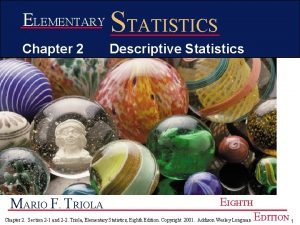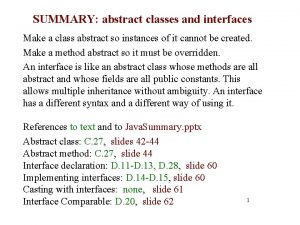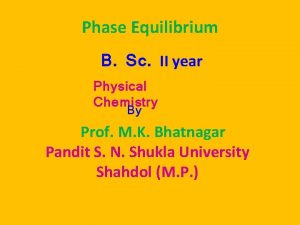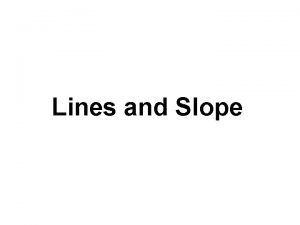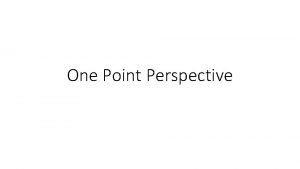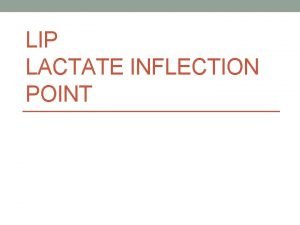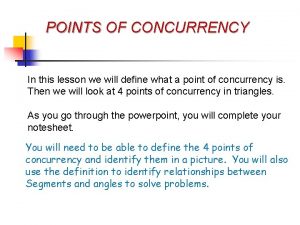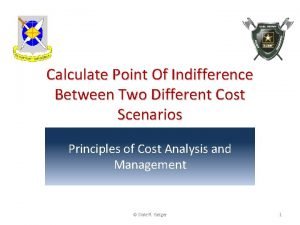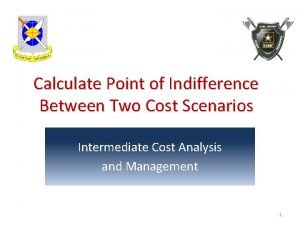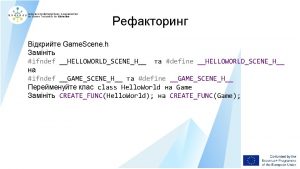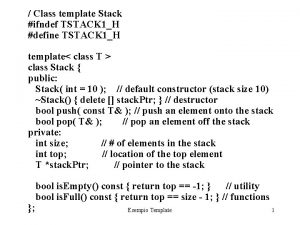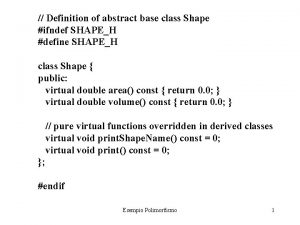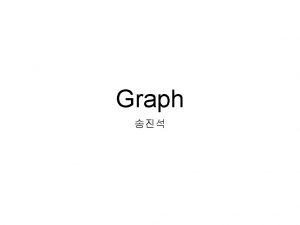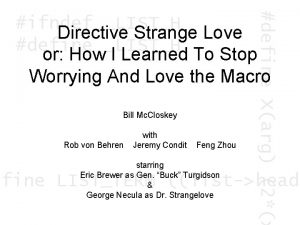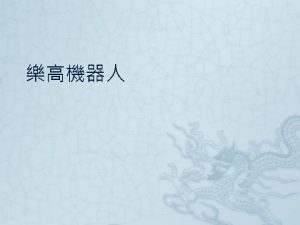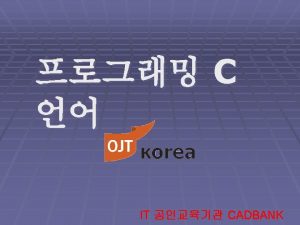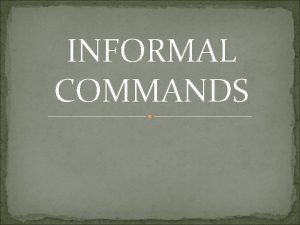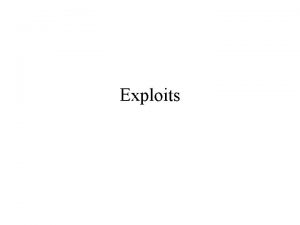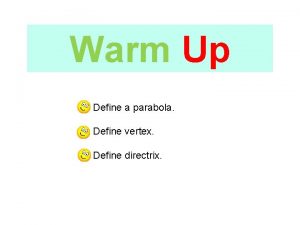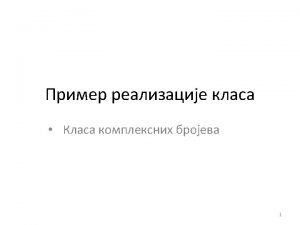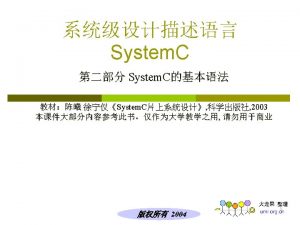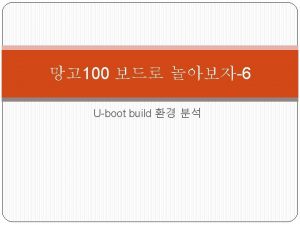Definition of class Point ifndef POINTH define POINTH








![Point p: [30, 50] Circle c: Center = [120, 89]; Radius = 2. 70 Point p: [30, 50] Circle c: Center = [120, 89]; Radius = 2. 70](https://slidetodoc.com/presentation_image_h2/be1eaaf8fd6b354338c94bce9ca980df/image-9.jpg)











- Slides: 20

// Definition of class Point #ifndef POINT_H #define POINT_H #include <iostream> using std: : ostream; class Point { friend ostream &operator<<( ostream &, const Point & ); public: Point( int = 0, int = 0 ); // default constructor void set. Point( int, int ); // set coordinates int get. X() const { return x; } // get x coordinate int get. Y() const { return y; } // get y coordinate protected: // accessible by derived classes int x, y; // x and y coordinates of the Point }; #endif Esempi Ereditarietà 1

// Member functions for class Point #include <iostream> #include "point. h" // Constructor for class Point: : Point( int a, int b ) { set. Point( a, b ); } // Set x and y coordinates of Point void Point: : set. Point( int a, int b ) { x = a; y = b; } // Output Point (with overloaded stream insertion operator) ostream &operator<<( ostream &output, const Point &p ) { output << '[' << p. x << ", " << p. y << ']'; return output; // enables cascaded calls } Esempi Ereditarietà 2

// Definition of class Circle #ifndef CIRCLE_H #define CIRCLE_H #include <iostream> using std: : ostream; #include <iomanip> using std: : ios; using std: : setiosflags; using std: : setprecision; #include "point. h" class Circle : public Point { // Circle inherits from Point friend ostream &operator<<( ostream &, const Circle & ); #endif Esempi Ereditarietà 3

public: // default constructor Circle( double r = 0. 0, int x = 0, int y = 0 ); void set. Radius( double ); // set radius double get. Radius() const; // return radius double area() const; // calculate area protected: double radius; }; Esempi Ereditarietà 4

// Member function definitions for class Circle #include "circle. h" // Constructor for Circle calls constructor for Point // with a member initializer then initializes radius. Circle: : Circle( double r, int a, int b ) : Point( a, b ) // call base-class constructor { set. Radius( r ); } // Set radius of Circle void Circle: : set. Radius( double r ) { radius = ( r >= 0 ? r : 0 ); } // Get radius of Circle double Circle: : get. Radius() const { return radius; } Esempi Ereditarietà 5

// Calculate area of Circle double Circle: : area() const { return 3. 14159 * radius; } // Output a Circle in the form: // Center = [x, y]; Radius = #. ## ostream &operator<<( ostream &output, const Circle &c ) { output << "Center = " << static_cast< Point >( c ) << "; Radius = " << setiosflags( ios: : fixed | ios: : showpoint ) << setprecision( 2 ) << c. radius; return output; // enables cascaded calls } Esempi Ereditarietà 6

// Casting base-class pointers to derived-class pointers #include <iostream> using std: : cout; using std: : endl; #include <iomanip> #include "point. h" #include "circle. h" int main() { Point *point. Ptr = 0, p( 30, 50 ); Circle *circle. Ptr = 0, c( 2. 7, 120, 89 ); cout << "Point p: " << p << "n. Circle c: " << c << 'n'; // Treat a Circle as a Point (see only the base class part) point. Ptr = &c; // assign address of Circle to point. Ptr cout << "n. Circle c (via *point. Ptr): " << *point. Ptr << 'n'; Esempi Ereditarietà 7

// Treat a Circle as a Circle (with some casting) // cast base-class pointer to derived-class pointer circle. Ptr = static_cast< Circle * >( point. Ptr ); cout << "n. Circle c (via *circle. Ptr): n" << *circle. Ptr << "n. Area of c (via circle. Ptr): " << circle. Ptr->area() << 'n'; // DANGEROUS: Treat a Point as a Circle point. Ptr = &p; // assign address of Point to point. Ptr } // cast base-class pointer to derived-class pointer circle. Ptr = static_cast< Circle * >( point. Ptr ); cout << "n. Point p (via *circle. Ptr): n" << *circle. Ptr << "n. Area of object circle. Ptr points to: " << circle. Ptr->area() << endl; return 0; Esempi Ereditarietà 8
![Point p 30 50 Circle c Center 120 89 Radius 2 70 Point p: [30, 50] Circle c: Center = [120, 89]; Radius = 2. 70](https://slidetodoc.com/presentation_image_h2/be1eaaf8fd6b354338c94bce9ca980df/image-9.jpg)
Point p: [30, 50] Circle c: Center = [120, 89]; Radius = 2. 70 Circle c (via *point. Ptr): [120, 89] Circle c (via *circle. Ptr): Center = [120, 89]; Radius = 2. 70 Area of c (via circle. Ptr): 22. 90 Point p (via *circle. Ptr): Center = [30, 50]; Radius = 0. 00 Area of object circle. Ptr points to: 0. 00 Esempi Ereditarietà 9

// Definition of class Point #ifndef POINT 2_H #define POINT 2_H #include <iostream> using std: : ostream; class Point { friend ostream &operator<<( ostream &, const Point & ); public: Point( int = 0, int = 0 ); // default constructor void set. Point( int, int ); // set coordinates int get. X() const { return x; } // get x coordinate int get. Y() const { return y; } // get y coordinate protected: // accessible to derived classes int x, y; // coordinates of the point }; #endif Esempi Ereditarietà 10

// Member functions for class Point #include "point 2. h" // Constructor for class Point: : Point( int a, int b ) { set. Point( a, b ); } // Set the x and y coordinates void Point: : set. Point( int a, int b ) { x = a; y = b; } // Output the Point ostream &operator<<( ostream &output, const Point &p ) { output << '[' << p. x << ", " << p. y << ']'; } return output; // enables cascading Esempi Ereditarietà 11

// Definition of class Circle #ifndef CIRCLE 2_H #define CIRCLE 2_H #include <iostream> using std: : ostream; #include "point 2. h" class Circle : public Point { friend ostream &operator<<( ostream &, const Circle & ); public: // default constructor Circle( double r = 0. 0, int x = 0, int y = 0 ); void set. Radius( double ); // set radius double get. Radius() const; // return radius double area() const; // calculate area protected: // accessible to derived classes double radius; // radius of the Circle }; #endif Esempi Ereditarietà 12

// Member function definitions for class Circle #include <iomanip> using std: : ios; using std: : setiosflags; using std: : setprecision; #include "circle 2. h" // Constructor for Circle calls constructor for Point // with a member initializer and initializes radius Circle: : Circle( double r, int a, int b ) : Point( a, b ) // call base-class constructor { set. Radius( r ); } // Set radius void Circle: : set. Radius( double r ) { radius = ( r >= 0 ? r : 0 ); } Esempi Ereditarietà 13

// Get radius double Circle: : get. Radius() const { return radius; } // Calculate area of Circle double Circle: : area() const { return 3. 14159 * radius; } // Output a circle in the form: // Center = [x, y]; Radius = #. ## ostream &operator<<( ostream &output, const Circle &c ) { output << "Center = " << static_cast< Point > ( c ) << "; Radius = " << setiosflags( ios: : fixed | ios: : showpoint ) << setprecision( 2 ) << c. radius; } return output; // enables cascaded calls Esempi Ereditarietà 14

// Definition of class Cylinder #ifndef CYLINDR 2_H #define CYLINDR 2_H #include <iostream> using std: : ostream; #include "circle 2. h" class Cylinder : public Circle { friend ostream &operator<<( ostream &, const Cylinder & ); public: // default constructor: Cylinder( double h = 0. 0, double r = 0. 0, int x = 0, int y = 0 ); void set. Height( double ); // set height double get. Height() const; // return height double area() const; // calculate and return area double volume() const; // calculate and return volume protected: double height; // height of the Cylinder }; #endif Esempi Ereditarietà 15

// Member and friend function definitions // for class Cylinder. #include "cylindr 2. h" // Cylinder constructor calls Circle constructor Cylinder: : Cylinder( double h, double r, int x, int y ) : Circle( r, x, y ) // call base-class constructor { set. Height( h ); } // Set height of Cylinder void Cylinder: : set. Height( double h ) { height = ( h >= 0 ? h : 0 ); } // Get height of Cylinder double Cylinder: : get. Height() const { return height; } Esempi Ereditarietà 16

// Calculate area of Cylinder (i. e. , surface area) double Cylinder: : area() const { return 2 * Circle: : area() + 2 * 3. 14159 * radius * height; } // Calculate volume of Cylinder double Cylinder: : volume() const { return Circle: : area() * height; } // Output Cylinder dimensions ostream &operator<<( ostream &output, const Cylinder &c ) { output << static_cast< Circle >( c ) << "; Height = " << c. height; return output; // enables cascaded calls } Esempi Ereditarietà 17

// Driver for class Cylinder #include <iostream> using std: : cout; using std: : endl; #include "point 2. h" #include "circle 2. h" #include "cylindr 2. h" int main( ) { // create Cylinder object Cylinder cyl( 5. 7, 2. 5, 12, 23 ); // use get functions to display the Cylinder cout << "X coordinate is " << cyl. get. X() << "n. Y coordinate is " << cyl. get. Y() << "n. Radius is " << cyl. get. Radius() << "n. Height is " << cyl. get. Height() << "nn"; Esempi Ereditarietà 18

// use set functions to change the Cylinder's attributes cyl. set. Height( 10 ); cyl. set. Radius( 4. 25 ); cyl. set. Point( 2, 2 ); cout << "The new location, radius, and height of cyl are: n" << cyl << 'n'; cout << "The area of cyl is: n" << cyl. area() << 'n'; // display the Cylinder as a Point &p. Ref = cyl; // p. Ref "thinks" it is a Point cout << "n. Cylinder printed as a Point is: " << p. Ref << "nn"; // display the Cylinder as a Circle &circle. Ref = cyl; // circle. Ref thinks it is a Circle cout << "Cylinder printed as a Circle is: n" << circle. Ref << "n. Area: " << circle. Ref. area() << endl; return 0; } Esempi Ereditarietà 19

X coordinate is 12 Y coordinate is 23 Radius is 2. 5 Height is 5. 7 The new location, radius, and height of cyl are: Center = [2, 2]; Radius = 4. 25; Height = 10. 00 Cylinder printed as a point is: [2, 2] Cylinder printed as a Circle is: Center = [2, 2]; Radius = 4. 25 Area = 56. 74 Esempi Ereditarietà 20
 Mesomeric effect
Mesomeric effect Define the health education
Define the health education Characteristics of inferential statistics
Characteristics of inferential statistics Abstract vs summary
Abstract vs summary Discuss the phase diagram of ferric chloride water system
Discuss the phase diagram of ferric chloride water system Slope definition
Slope definition Define one point perspective
Define one point perspective What is the lactate inflection point
What is the lactate inflection point Point processing in image processing example
Point processing in image processing example Orthocenter practice problems
Orthocenter practice problems Cost indifference point formula
Cost indifference point formula Cost indifference point formula
Cost indifference point formula There is class today
There is class today Putting a package together
Putting a package together Abstract class vs concrete class
Abstract class vs concrete class How to calculate mode for grouped data
How to calculate mode for grouped data Class i vs class ii mhc
Class i vs class ii mhc Abstract concrete class relationship
Abstract concrete class relationship How to get class boundary
How to get class boundary Stimulus
Stimulus Stimulus class vs response class
Stimulus class vs response class


